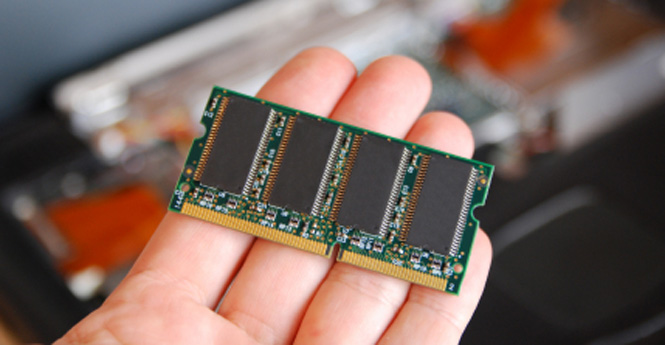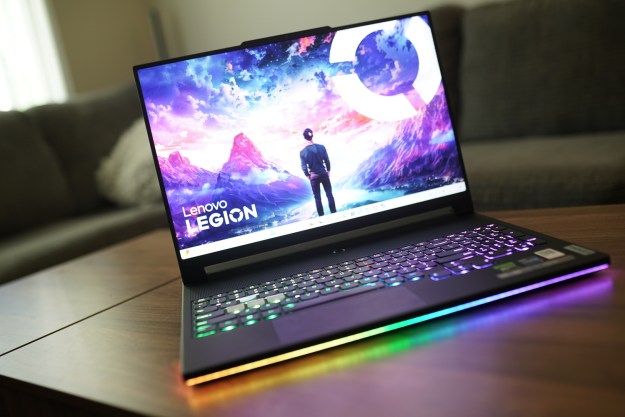
The old axiom that you can’t upgrade a laptop has never been less true. Sure, your nay-saying, desktop-bound friends who repeat it have a basic kernel of truth in their favor – the core guts of a mobile machine are pretty much set in stone. But if you’re not looking to completely revamp a computer (which can hardly be called an upgrade anyway), aftermarket manufacturers have found plenty of clever ways to skirt the issue of expandability, and slap new parts onto your aging laptop, giving it new functionality that may not have even been possible when it was built. So if your $2,000 wonder machine from three years ago doesn’t seem quite so wondrous any more, but another two grand for a new model isn’t in the budget at the moment, here are some inexpensive ways to hop up the old girl and get her running like never before.
Memory
Don’t beat yourself up for not choosing more RAM right from the factory when you originally ordered your laptop – you actually made the right choice. RAM is one of the easiest laptop components to add for yourself, and you’ll pay a hefty premium to get it preinstalled on a new machine, anyway. (Lenovo, for instance, charges $150 to deck out a brand new X301 with 4GB of PC3-8500 RAM, when you can buy the same stuff for about $60 on your own right now.)
Check your notebook’s manual for two critical specs: the speed of the RAM, and how many DIMM slots you have. Most notebooks will have two, and accommodate a maximum of 4GB of RAM, meaning you should invest in two sticks of 2GB memory to deck it out. If you plan on keeping some of the existing memory, open your notebook to see how it’s spread out. Two 1GB sticks of RAM adding up to a total of 2GB will still have to replaced, if you plan on moving to 4GB and only have two DIMM slots. That said, keep in mind that more than 3GB of memory goes to waste in operating systems that aren’t 64 bit, so don’t go overboard if you can’t use it, either.
On most notebooks, installing RAM is as simple as unscrewing a small door on the bottom, unclipping the old DIMMs, and dropping in the new. Check out this YouTube video to get some idea what you’re in for.
Hard Drives
Most people could pop a hard drive from a laptop in seconds after learning how, but that doesn’t make it an easy item to replace. The physical swap may be easy, but you’ll have to move the contents from one drive to another, too, which can be considerably more complex. We recommend amateurs consider adding on to existing storage by buying an external drive, if they don’t absolutely need the storage to be built in. Our PC upgrade guide offers an excellent overview to the various connectors and speeds you’ll have to choose from.
However, if you do decide you need that internal drive to get bigger, make sure to purchase the right type. All notebook drives measure 2.5 inches wide, but you’ll need to pay attention to the connector used: IDE, SATA, or the relatively rare ZIF. Chances are, unless you’re updating a real clunker, you’re dealing with a SATA drive. After that, it’s just a matter of dealing with size and speed. Size will of course depend on how much more space you want to add, while speed should only really be a concern if you want to increase performance, too. Drives that run at 5400RPM are fairly standard, while 7200RPM drives will give a slight speed bump, and switching to a pricy solid-state drive will speed things up even more, in addition to making your notebook more resistant to bumps. Listen to more reasons you may want to invest in an SSD from our podcast on SSD basics.
The issue of how to move all that data gets trickier. You can either back up your files (on DVDs or to the Web, for instance) and reinstall an operating system from scratch on the fresh drive, or choose to “clone” your existing drive, which will basically restore your PC to the exact same state it was in on the old drive. Backing up and reinstalling can be time consuming, but it’s less difficult than the alternative, and most PCs will benefit from the decluttering, anyway. To clone the drive, you’ll need to purchase hardware that basically converts it to an external drive, allowing you to connect it while the original drive is still inside your laptop, so you can use special software (which you can download for free) to copy everything over. If you own a desktop, you can also buy adapter s to connect the old and new drives simultaneously for cloning.
Monitors
The display that came on your laptop is the display you’re stuck with. Even though some manufacturers offer multiple displays for the same notebook, the lack of standardization in LCD panel connectors (it’s not just a mini DVI plug in there, you know) means there’s no guarantee that the higher-resolution screen you’ve always dreamed of would connect up seamlessly with your machine if you trying to implant it.
However, that doesn’t rule out an external display, which makes a nice desktop add-on for those who use their laptops at a desk most of the time. Virtually all notebooks include external VGA or DVI connectors, meaning you can hook up any standard monitor intended for a desktop – just make sure that the video card inside can handle driving it at the native resolution. The weak little video card in most netbooks, for instance, won’t drive an external display at 1920 x 1080, so make sure to consult your manuals before buying that 30-incher.
Speakers
Much like your laptop display, the speakers embedded above your notebook keyboard aren’t going to get any better than they are. But as you probably already know, adding a pair of headphones or stereo speakers using the audio out jack improves sound dramatically, and it’s a cinch. What if you want surround sound? Not too long ago, it would have been impossibility, because 5.1 surround speakers usually come with a nasty tangle of colored jacks that have nowhere to plug in on most notebooks. But PC speaker manufacturers have gotten a lot better at accommodating notebooks lately. The new solution: speakers that use a USB connection instead. With some brilliant hardware wrangling, some speakers, like Altec Lansing’s FX5051, can pull all those audio channels from your laptop digitally over a USB connection, rather than with analog jacks you don’t have. Chips within the speaker system itself convert that digital audio to analog signals for the satellite speakers, and – voila – you have surround sound from a single, universal connection. Isn’t technology great?
USB Accessories
While the speed of USB 1.0 connections used to severely limit their utility for anything more than accessories like mice, the speedy USB 2.0 standard ushered in a whole new era of expandability. We’re reminded of an old college roommate who had so many USB accessories tied into his laptop, he had to cobble together a wooden frame to keep them all together. These days, you can get anything from external hard drives to DVD burners, Blu-ray players, sound cards, and even oddball accessories like craning LED keyboard lights. Long story short: If you would add it as a PCI card to a desktop, you can probably find a USB version for your laptop.
Notebook Expansion Cards
If you don’t want things dangling by USB cables all over your laptop, using the built-in expansion slots in your notebook makes a lot more sense. Older notebook usually accept PC cards (also called PCMCIA cards), while newer notebooks use faster ExpressCards. In either case, adding a Wi-Fi adapter, WWAN adapter, sound card, or even solid-state drive is usually as simple as buying it, installing drivers, and popping it in, making it one of the most foolproof ways to upgrade possible.
Batteries
Unlike most notebook components that will function the same after 10 years of use as they will after 10 days of use, lithium-ion batteries gradually lose their ability to hold charge over time. So replacing your battery when the old one starts to zonk out can be considered an upgrade or maintenance, depending on how you look at it.
But even if your battery isn’t on verge of death, a new battery can dramatically increase your time spent away from outlets. Many manufacturers offer multiple batteries for the same notebook, meaning you might be able to score one with twice the capacity as the stock model your machine shipped with.
Most companies just use the number of cells in a given battery pack to give some indication of capacity. A slim battery, for instance, might carry four cells, while a bulkier extended-run battery might have eight cells. But a better, more objective indicator of battery performance is milliamp hours, usually expressed as mAh. In general, you can expect that number to translate directly to run time, so if a 2400 mAh battery delivers two hours in your notebook, you can expect four hours after stepping up to a 4800 mAh model. Just keep in mind that added cells mean added weight, so you may not want to want to make the trade off if you’re already content with your current battery.
Editors' Recommendations
- Save $450 on this 17-inch HP gaming laptop with an RTX 4060
- Best HP laptop deals: Get a 17-inch workhorse for $370 and more
- Best refurbished laptop deals: How to find cheap used computers
- This 17-inch HP laptop is on sale for just $300 — but hurry!
- This Lenovo laptop is usually $1,700 — today it’s $847


